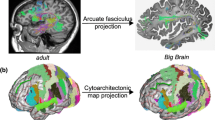Abstract
Modeling neurodevelopment in brain asphyxia is a crucial task in pediatric medical imaging. One of the significant challenges is that brain structures that are affected by encephalopathy lose their mass due to the injury. Thus, quantifying neurodevelopmental changes is often performed using 2D approaches where the neuroradiologist performs fiducial landmarks to monitor clinical outcomes. We showed how non-rigid correspondence analysis allows relevant quantification of shape relations on brain structures. We use functional maps to automatically compute shape correspondences based on partially observed 3D shapes (i.e., affected brain areas). We perform the brain structure representation as partial functional correspondences between the affected brain area at a post-injury time and model shapes related to the first brain representation (i.e., the first month after birth). Hence, eigenfunctions with the Laplace-Beltrami operator are computed from the training shapes. Then, we apply an optimization process where fine-tuning the functional maps results in meaningful matches between brain structures. The experimental results show that our approach computes reliability correspondences, and establishes candidate matches for robust neurodevelopmental quantification.
Access this chapter
Tax calculation will be finalised at checkout
Purchases are for personal use only
Similar content being viewed by others
References
Besl, P.J., McKay, N.D.: A method for registration of 3-D shapes. IEEE Trans. Pattern Anal. Mach. Intell. 14, 239–256 (1992)
Bronstein, A., Bronstein, M., Kimmel, R.: Numerical Geometry of Non-Rigid Shapes. Monographs in Computer Science, Springer, New York (2009). https://books.google.com.co/books?id=de2jrRCNpwEC
Bronstein, M.M., Kokkinos, I.: Scale-invariant heat kernel signatures for non-rigid shape recognition. In: 2010 IEEE Computer Society Conference on Computer Vision and Pattern Recognition, pp. 1704–1711. IEEE (2010)
Dyke, R.M., et al.: SHREC’20: shape correspondence with non-isometric deformations. Comput. Graph. 92, 28–43 (2020)
Eynard, D., Rodola, E., Glashoff, K., Bronstein, M.M.: Coupled functional maps. In: 2016 Fourth International Conference on 3D Vision (3DV), pp. 399–407. IEEE (2016)
Gousias, I., et al.: Magnetic resonance imaging of the newborn brain: manual segmentation of labelled atlases in term-born and preterm infants. Neuroimage 62(3), 1499–1509 (2012). https://doi.org/10.1016/j.neuroimage.2012.05.083. Sep
Huang, Q., Wang, F., Guibas, L.: Functional map networks for analyzing and exploring large shape collections. ACM Trans. Graph. 33(4) (2014). https://doi.org/10.1145/2601097.2601111
Kalogerakis, E., Hertzmann, A., Singh, K.: Learning 3D mesh segmentation and labeling. ACM Trans. Graph. 29, 1 (2010). https://doi.org/10.1145/1833351.1778839
Litman, R., Bronstein, A.M.: Learning spectral descriptors for deformable shape correspondence. IEEE Trans. Pattern Anal. Mach. Intell. 36(1), 171–180 (2013)
Ovsjanikov, M.: Shape correspondence and functional maps. In: Handbook of Numerical Analysis, vol. 19, pp. 91–118. Elsevier (2018)
Ovsjanikov, M., Ben-Chen, M., Solomon, J., Butscher, A., Guibas, L.: Functional maps: a flexible representation of maps between shapes. ACM Trans. Graph. 31(4) (2012). https://doi.org/10.1145/2185520.2185526
Rustamov, R.M., Ovsjanikov, M., Azencot, O., Ben-Chen, M., Chazal, F., Guibas, L.: Map-based exploration of intrinsic shape differences and variability. ACM Trans. Graph. 32(4) (2013). https://doi.org/10.1145/2461912.2461959
Setumin, S., Aminudin, M.F.C., Suandi, S.A.: Canonical correlation analysis feature fusion with patch of interest: a dynamic local feature matching for face sketch image retrieval. IEEE Access 8, 137342–137355 (2020)
Van Kaick, O., Zhang, H., Hamarneh, G., Cohen-Or, D.: A survey on shape correspondence. In: Computer Graphics Forum, vol. 30, pp. 1681–1707. Wiley Online Library (2011)
Weng, Y., Xu, W., Wu, Y., Zhou, K., Guo, B.: 2D shape deformation using nonlinear least squares optimization. Visual Comput. 22, 653–660 (2006). https://doi.org/10.1007/s00371-006-0054-y
Zöllei, L., Iglesias, J.E., Ou, Y., Grant, P.E., Fischl, B.: Infant FreeSurfer: an automated segmentation and surface extraction pipeline for T1-weighted neuroimaging data of infants 0–2 years. Neuroimage 218, 116946 (2020)
Acknowledgments
We thank the Ministry of Sciences of Colombia for financing the project with code 4979-844-67090, CTO 858-2019.
Author information
Authors and Affiliations
Corresponding author
Editor information
Editors and Affiliations
Rights and permissions
Copyright information
© 2022 The Author(s), under exclusive license to Springer Nature Switzerland AG
About this paper
Cite this paper
Arias-Garcia, J., Garcia, H.F., Orozco, Á.A., Porras-Hurtado, G.L., Cárdenas-Peña, D.A., Ríos-Patiño, J.I. (2022). Brain Shape Correspondence Analysis Using Functional Maps. In: Bebis, G., et al. Advances in Visual Computing. ISVC 2022. Lecture Notes in Computer Science, vol 13599. Springer, Cham. https://doi.org/10.1007/978-3-031-20716-7_1
Download citation
DOI: https://doi.org/10.1007/978-3-031-20716-7_1
Published:
Publisher Name: Springer, Cham
Print ISBN: 978-3-031-20715-0
Online ISBN: 978-3-031-20716-7
eBook Packages: Computer ScienceComputer Science (R0)




